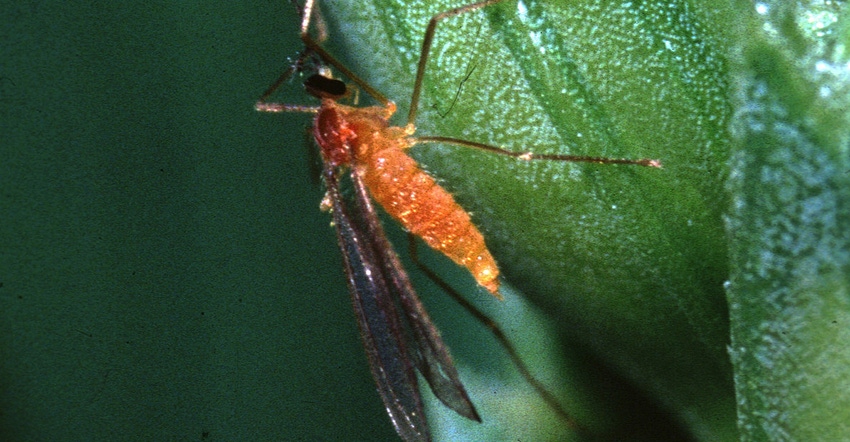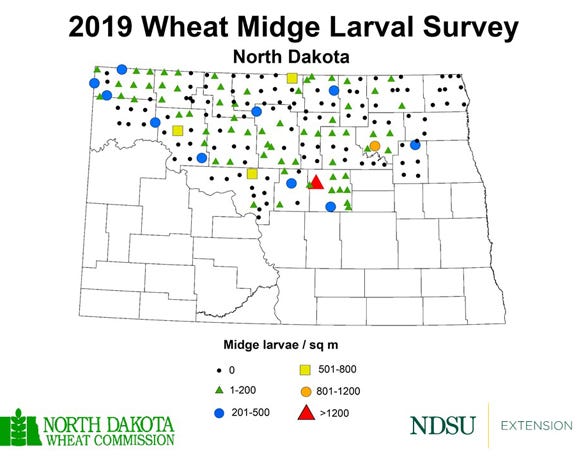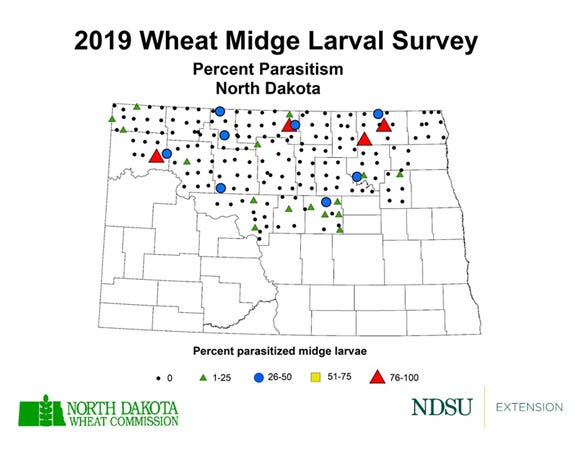March 4, 2020

Soil samples indicate that number of wheat midge larvae in some North Dakota fields has risen dramatically, says Janet Knodel, North Dakota State University Extension entomologist.
An insecticide application will probably need to be applied in some areas of the state to prevent the insect from causing wheat yield losses, she says.
Survey says
In the fall of 2019, NDSU specialists collected 1,900 soil samples from 20 counties. About 1% of the soil samples had very high population densities of wheat midge, greater than 800 midge larvae per square meter. The hot spots are in west-central Wells County and southwestern Ramsey County.
Another 2% was at a high-risk level (501 to 800 midge larvae per square meter) in northeastern Bottineau County, central Mountrail County and northeastern McLean County.
“These populations are high and indicate that an insecticide will probably be needed to reduce potential yield loss from wheat midge, assuming wheat is in the susceptible growth stages during midge emergence and midge populations are at economic threshold levels during field scouting,” Knodel says.
 MIDGE LARVAE: Survey results from fall 2019, displaying midge larva per square meter.
MIDGE LARVAE: Survey results from fall 2019, displaying midge larva per square meter.

The moderate risk level (201 to 500 midge larvae per square meter) also was observed in 5% of the samples. Moderate risk areas were scattered in eight counties throughout the state, including the northeastern area (Nelson County), the central area (Sheridan and Wells counties), the north-central area (McHenry and Rolette counties), and the northwestern area (Divide, Mountrail, Williams counties).
“These population levels are considered non-economic for wheat midge,” Knodel says.
Thirty-four percent of the soil samples were at low risk. No cocoons were found in 58% of the samples. In 2108, 84% of the samples had no cocoons, a record low for the state.
The increase in wheat midge populations in 2019 is probably due to the rain, Knodel says.
When to scout
Scout for wheat midge adults when wheat is in early the early flowering stage (less than 50% flowering). Look for them at night when temperatures are greater than 59 degrees F and the winds are less than 6 mph. “Use a flashlight and slowly scan the heads of wheat plants for wheat midge adults, counting the number of flies per head,” Knodel says.
 PERCENT PARATISM: Survey results from fall 2019, displaying the percent parasitized midge larvae.
PERCENT PARATISM: Survey results from fall 2019, displaying the percent parasitized midge larvae.

The economic thresholds for wheat midge are:
one or more midge observed for every four or five heads on hard red spring wheat
one or more midge observed for every seven or eight heads on durum wheat
Knodel recommends using the wheat midge degree-day model from North Dakota Agricultural Weather Network to predict the emergence of wheat midge.
Select your nearest NDAWN station and enter your wheat planting date. The output indicates the expected growth stage of the wheat and whether the crop is susceptible to midge infestation, as well as the timing of wheat midge emergence.
Protect wasps
Wheat midge larvae numbers would be much higher if it weren’t for parasitic wasps. It 2019, the average parasitism rate was about 36% compared with less than 5% between 2015 and 2018. The highest parasitism rates were found in Bottineau, Cavalier and Williams counties.
“We need to continue to conserve parasitic wasp populations by scouting for wheat midge and spraying insecticides only when wheat midge populations are at economic threshold levels,” Knodel says. “Parasitic wasps fly later than wheat midge, so avoiding any late insecticide applications also will reduce the negative impacts on these ‘good’ insects. This tiny, metallic wasp does an excellent job keeping the wheat midge in check by providing free biological control of wheat midge in wheat fields.”
Source: NDSU Agriculture Communication, which is solely responsible for the information provided and is wholly owned by the source. Informa Business Media and all its subsidiaries are not responsible for any of the content contained in this information asset.
You May Also Like




